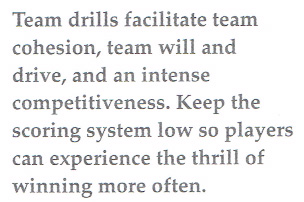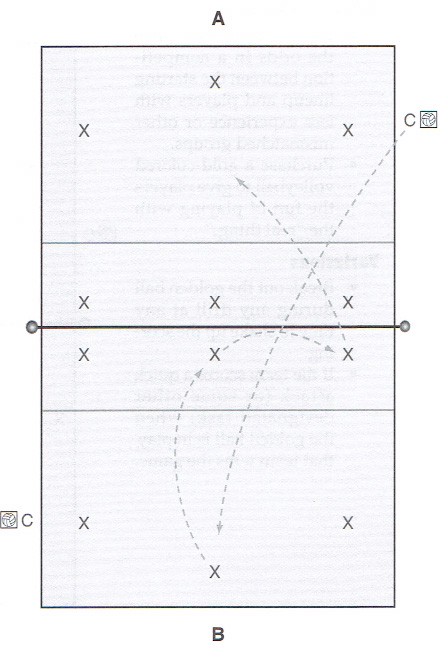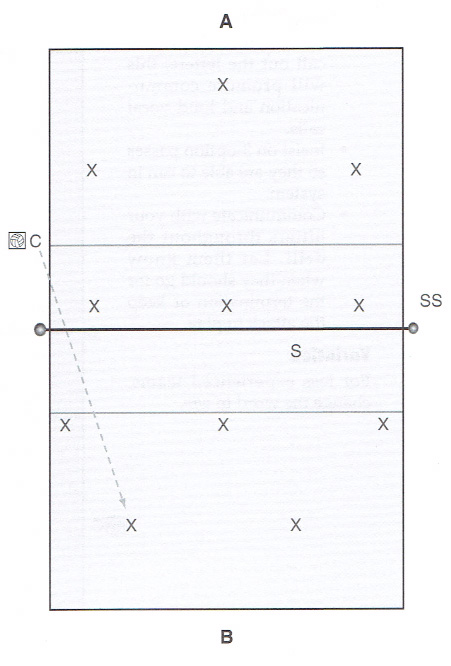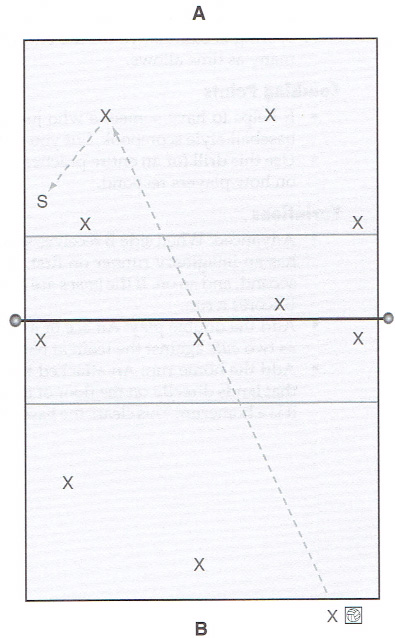| Team Scoring Drills |
| By: Teri Clemens and Jenny McDowell
Originally Published in: The Volleyball Drill Book Provided by: Human Kinetics Team scoring drills work well in mid season and postseason. These drills should not routinely make up the bulk of practice time, but they can on given days. If a team neglects team drills and focuses only on individual and small-group drills, the team may not play well together and may appear disjointed. Team play allows players to develop flow and to work smoothly as a cohesive, coordinated unit. Practicing these drills allows coaches to see what works well, who works well together, and which aspects of the game still need to be worked on in small groups. Team drills promote player development in leadership, followership, fellowship, decision making, respect, discipline, and more. Quick hand slapping, team yells, encouragement to teammates, and pats on the back are important components of the drills. You can determine substitutions and assign them before the drill. Specify your expectations regarding substitutions so that the process does not affect the flow of play. Players can substitute quickly after low-scoring games or during games if players know ahead of time who switches with whom and when-after a predetermined number of plays, points, or contacts. Expect surprises. Expect to stop. Expecting and dealing with the unexpected are what you and your players need to do on game day. Embrace unexpected events, but don't let them derail the practice. It is not necessary to play to 25 every time your team plays a competition at practice, but it is necessary to do it sometimes. Mostly, create short games. Then, in true matches, remind them to break the long game of 25 points into smaller, attainable goals. It is also important to play games in practice that allow players to learn to handle gamelike scores, such as 23 to 24 or 24 to 23. Give players the chance to play the underdog and fight to come back and win. Let them also learn to feel comfortable moving from a 1-point lead to a solid victory. You can put these experiences in your pocket and remind your players when this happens in a game that the situation is not unique and they've faced it before. Rehearsing circumstances like these in practice reduces the stress when they occur in matches. The most important reason for doing 6v6 drills in practice is to provide match-day opportunities for players. This type of drill is the dress rehearsal for matches. Remember to address match-day details such as lineups, changing of sides, substitution rules, ball shagging, and so on. Every issue you must deal with in a contest should be addressed. If every-thing is well rehearsed, players are comfortable on match day. It is then a fun day of competition rather than a stress-filled, stomach-churning nightmare. Not surprisingly, if the team is well rehearsed, the coach is also more comfortable during the event and can better respond to the needs of the team as the match progresses. Team scoring drills are winning opportunities for all involved. RALLY Purpose To establish control of the pass, set, and attack and end with a termination. Setup Six players set up on each side of the net, with players on both team A and team in their specialized positions. One coach is on the sideline of side A with a basket of balls. Another coach is on the sideline on side B with a basket of balls. Run the Drill 1. The coach on side A sends a free ball to the team on side B, who must pass, set, and attack the ball. 2. Every time the ball crosses the net, both teams and subs yell out the next letter in the word rally: R-A-L-L-Y. 3. Once the last letter is called and the full word had been spelled out, the teams attempt to terminate the ball. 4. The team that errs or does not win the point receives the next free ball from the coach on the opposite side of the net. 5. Each termination scores a point. The first team to 7 points wins.
Coaching Points • Be sure that all players call out the letters; this will promote communication and loud vocal calls. • Insist on 3-option passes so they are able to run in system. • Communicate with your hitters throughout the drill. Let them know when they should go for the termination or keep the attack in play. Variation For less experienced teams, change the word to win. GOLDEN BALL Purpose To provide a gamelike competition with the added pressure and joy of a bonus ball and decision-making opportunity. Setup Two teams of six set up on opposites sides of the court. Substitutes are predetermined. A coach and basket of balls are at the side of the court. A scorekeeper is on the sideline near the net. Run the Drill 1. The coach enters the ball by tossing or hitting to either side. 2. The team that wins the rally gets 1 point, and the coach tosses in another ball. 3. Teams play to 15 points. 4. At a point in the drill of the coach's choosing, the coach tosses in the golden ball, which is a different color or specially marked. The winner of the golden-ball rally can alter the score by declaring it tied or by awarding themselves 3 points, whichever they prefer. Coaching Points • Use this drill to equalize the odds in a competition between the starting lineup and players with less experience or other mismatched groups. • Purchase a gold-colored volleyball to give players the fun of playing with the "real thing". Variations • Break out the golden ball during any drill at any time to shake up the scoring. • If the team scores a quick attack(or some other designated task) when the golden ball is in play, that team wins the game. ROTATION RACE This is a 6v6 serve-receive contest. Purpose To practice serve-receive patterns in all rotations. Setup Six players set up on each side of the court. Side A always receives. Side B always serves. A basket of balls is on the end-line of side B. If there are more than 12 players, the coach preassigns substitutions. Run the Drill 1. Side B serves to side A. 2. Players rally until the ball is dead. 3. The winner of the rally receives 1 point. 4. Side A (receiving team) must score 2 points in each rotation. 5. The serving team tries to score 12 before the opponent scores 15. 6. Side B does not rotate. The three back-row players alternate serving. 7. The serving team is allowed three missed serves, then side A scores a point for each missed serve. This encourages aggressive serving. 8. The winning team can choose to serve or receive the following game. Coaching Points • For a beginning team, keep serve-receive positioning simple, but start letting primary passers into key positions. • Use this opportunity to discuss overlapping. Variations • Award a bonus point for scoring on a first attack for the receiving team and rotate automatically. • Award a bonus point for an ace. |



 Enjoy victories. Be as specific as possible with your instructions. Keep your corrections, suggestions, and comments brief and to the point. Conditions should be as game-like as possible during team scoring drills.
Enjoy victories. Be as specific as possible with your instructions. Keep your corrections, suggestions, and comments brief and to the point. Conditions should be as game-like as possible during team scoring drills.





